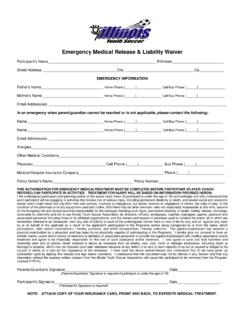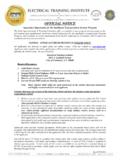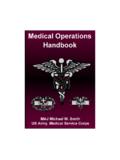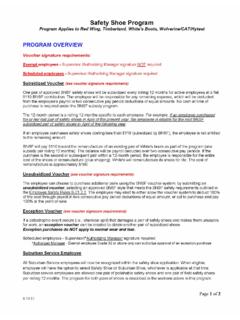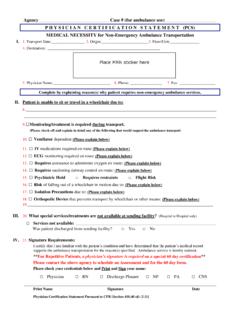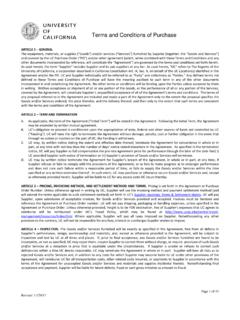Transcription of Handling, storage, and transportation of health …
1 handling , storage , and transportation of health -care waste61 handling , storage , andtransportation of Waste segregation and packagingThe key to minimization and effective management of health -care wasteis segregation (separation) and identification of the waste. Appropriatehandling, treatment, and disposal of waste by type reduces costs anddoes much to protect public health . Segregation should always be theresponsibility of the waste producer, should take place as close as pos-sible to where the waste is generated, and should be maintained instorage areas and during transport. The same system of segregationshould be in force throughout the most appropriate way of identifying the categories of health -carewaste is by sorting the waste into colour-coded plastic bags or recommended colour-coding scheme is given in Table addition to the colour coding of waste containers, the following prac-tices are recommended: General health -care waste should join the stream of domestic refusefor disposal.
2 Sharps should all be collected together, regardless of whether or notthey are contaminated. Containers should be puncture-proof (usuallymade of metal or high-density plastic) and fitted with covers. Theyshould be rigid and impermeable so that they safely retain not onlythe sharps but also any residual liquids from syringes. To discourageabuse, containers should be tamper-proof (difficult to open or break)and needles and syringes should be rendered unusable. Where plasticor metal containers are unavailable or too costly, containers made ofdense cardboard are recommended (WHO, 1997); these fold for ease oftransport and may be supplied with a plastic lining. See Fig.
3 Bags and containers for infectious waste should be marked with theinternational infectious substance symbol (see Fig. ). Highly infectious waste should, whenever possible, be sterilized imme-diately by autoclaving. It therefore needs to be packaged in bags thatare compatible with the proposed treatment process: red bags, suitablefor autoclaving, are recommended. Cytotoxic waste, most of which is produced in major hospital or re-search facilities, should be collected in strong, leak-proof containersclearly labelled Cytotoxic wastes . Small amounts of chemical or pharmaceutical waste may be collectedtogether with infectious waste. Large quantities of obsolete or expired pharmaceuticals stored in hos-pital wards or departments should be returned to the pharmacy fordisposal.
4 Other pharmaceutical waste generated at this level, such asspilled or contaminated drugs or packaging containing drug residuesshould not be returned because of the risk of contaminating the phar-7 Safe management of wastes from health -care activities62 Table colour-coding for health -care wasteType of wasteColour of container andType of containermarkingsHighly infectious wasteYellow, markedStrong, leak-proof plastic bag, HIGHLYor container capable ofINFECTIOUS being autoclavedOther infectious waste,YellowLeak-proof plastic bag orpathological andcontaineranatomical wasteSharpsYellow, markedPuncture-proof container SHARPS Chemical and pharmaceuticalBrownPlastic bag or containerwasteRadioactive wastea Lead box, labelled with theradioactive symbolbGeneral health -care wasteBlackPlastic bagaOnly generated in major hospitals; see also section Fig.
5 ; it should be deposited in the correct container at the point ofproduction. Large quantities of chemical waste should be packed in chemical-resistant containers and sent to specialized treatment facilities (ifavailable). The identity of the chemicals should be clearly marked onthe containers: hazardous chemical wastes of different types shouldnever be mixed. Waste with a high content of heavy metals ( cadmium or mercury)should be collected separately. Aerosol containers may be collected with general health -care wasteonce they are completely empty, provided that the waste is not des-tined for incineration. Low-level radioactive infectious waste ( swabs, syringes for diag-nostic or therapeutic use) may be collected in yellow bags or containersfor infectious waste if these are destined for infectioussubstance symbolFig.
6 Cardboardsharps containerHandling, storage , and transportation of health -care waste63 Since costs for safe treatment and disposal of hazardous health -carewaste are typically more than 10 times higher than those for generalwaste, all general, non-hazardous, waste should be handled in thesame manner as domestic refuse and collected in black bags. No health -care waste other than sharps should be deposited in sharps containers, asthese containers are more expensive than the bags used for other infec-tious waste. Measures of this sort help to minimize the costs of health -care waste collection and treatment. When a disposable syringe is used,for example, the packaging should be placed in the general waste bin andthe used syringe in the yellow sharps container.
7 In most circumstances,the needle should not be removed from the syringe because of the risk ofinjury; if removal of the needle is required, special care must be containers or bag holders should be placed in all locationswhere particular categories of waste may be generated. Instructions onwaste separation and identification should be posted at each waste collec-tion point to remind staff of the procedures. Containers should beremoved when they are three-quarters full. Examples of suitable con-tainers and bags are shown in Fig. and Plates Ideally, theyshould be made of combustible, non-halogenated should never attempt to correct errors of segregation by removingitems from a bag or container after disposal or by placing one bag insideanother bag of a different colour.
8 If general and hazardous wastes areaccidentally mixed, the mixture should be treated as hazardous health -care and religious constraints in certain countries make it unaccept-able for anatomical waste to be collected in the usual yellow bags; suchwaste should be disposed of in accordance with local custom, whichcommonly specifies containers recommended for small hospitals in ThailandaaSource: Ministry of health (1995), Handbook of hazardous healthcare waste management in 10-bed and 30-bed community hospitals, Bangkok; used with waste containermade from oil drum cut in halfCylinder-type plastic waste container with foot-operated lidSafe management of wastes from health -care On-site collection, transport, and storage of CollectionNursing and other clinical staff should ensure that waste bags are tightlyclosed or sealed when they are about three-quarters full.
9 Light-gaugebags can be closed by tying the neck, but heavier-gauge bags probablyrequire a plastic sealing tag of the self-locking type. Bags should not beclosed by stapling. Sealed sharps containers should be placed in a la-belled, yellow infectious health -care waste bag before removal from thehospital ward or should not be allowed to accumulate at the point of production. Aroutine programme for their collection should be established as part ofthe health -care waste management recommendations should be followed by the ancillary workers incharge of waste collection: Waste should be collected daily (or as frequently as required) andtransported to the designated central storage site.
10 No bags should be removed unless they are labelled with their point ofproduction (hospital and ward or department) and contents. The bags or containers should be replaced immediately with new onesof the same supply of fresh collection bags or containers should be readily availableat all locations where waste is StorageA storage location for health -care waste should be designated inside thehealth-care establishment or research facility. The waste, in bags orcontainers, should be stored in a separate area, room, or building of a sizeappropriate to the quantities of waste produced and the frequency ofcollection. Recommendations for the storage area and its equipment arelisted in Box a refrigerated storage room is available, storage times for health -care waste ( the delay between production and treatment) should notexceed the following:temperate climate: 72 hours in winter48 hours in summerwarm climate:48 hours during the cool season24 hours during the hot seasonCytotoxic waste should be stored separately from other health -care wastein a designated secure waste should be stored in containers that prevent dispersion,behind lead shielding.












